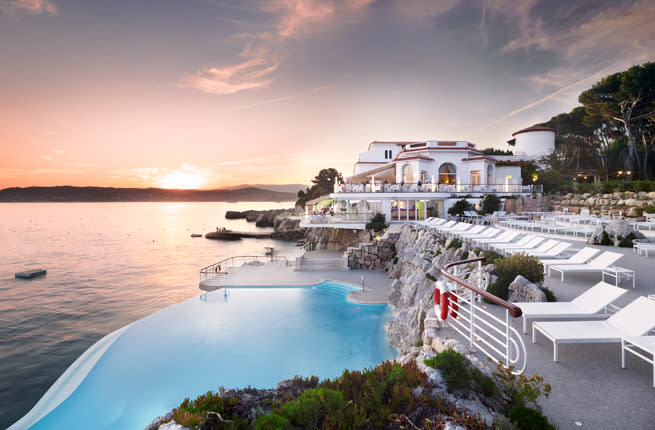Retire to the Sweet Life in Southwest France

Where: Cap d'Antibes, France
It’s hard to imagine a more glamorous hotel in the south of France than the . Located in the Cap d'Antibes, this hotel has hosted the likes of the Duke and Duchess of Windsor and Marlene Dietrich, as well as Marc Chagall, who spent days sketching on the beach. F. Scott and Zelda Fitzgerald were frequent guests, and the hotel makes an appearance in Tender is the Night (renamed the Hôtel des Étrangers). The Hôtel du Cap was famous for only accepting cash and wire transfers until 2006, and it's the place to stay during the .
Insider Tip: The hotel underwent a $67 million renovation in 2011; adding televisions to the guest rooms was one of the biggest changes made.
Plan Your Trip: Visit
(Jean-Michel Sordello)One of France's most beautiful and charming regions is so tucked away that even the French find it hard to place on the map. From the Romans to the Renaissance, and from the Belle Époque to the Art Deco era, history is everywhere in this part of France, along with rolling wooded countryside, friendly people and delicious wines and food. This is the birthplace of a great French king, was the seasonal favorite of royalty of all nations, was once named as "the center of the sporting world" and was home to the first-ever Grand Prix and the Wright Brothers' flying school. Rightly proud of its past, this area has also embraced the present with impressive 21 st century architecture, technology parks, sporting facilities and trail-blazing communications infrastructure. The Pyrenees Mountains dominate the views, and beaches are just a short drive away.
Indeed, the Béarn region in the southwest of France seems to have it all. As a result, this area offers one of the country's most appealing retirement lifestyle options.
Bordered by the Landes, Gers, High-Pyrenees and the Atlantic Ocean to the west, and Spain to the south, the Béarn has been influenced by many cultures, yet holds on to its own. It is 3,000 meters from the lowest part of the Plein de Nay to the highest point in the Pyrenees, but despite all this variation in geography, the Béarn has a gentle climate with regular sunshine that supports both pleasant living year-round and successful agricultural and wine industries. It seems that almost anything grows well here: Palm trees and the occasional banana plant sway alongside pine trees with the snow-capped Pyrenees rising up behind.
The Béarn hides many pretty little towns, but one stands out as especially appealing for retirees: Morlaàs. Morlaàs is a good size, and not too big or small. It is welcoming, offering every facility and service you would need to live comfortably day-to-day, as well as an interesting historic center and beautiful surrounding countryside.
Morlaàs is 12 kilometers north of Pau, up on a ridge overlooking the Plain of Pau that runs across the area. To the south are views of the Pyrenees, and to the north the undulating wooded farmland continues on toward Bordeaux. Morlaàs is home to just over 4,000 inhabitants, known locally as Morlanais.
After the Roman city of Beneharnum was destroyed by the Vikings in 840, Morlaàs became the capital of the ancient province of Béarn. During that time, it even had its own mint. Money from Morlaàs was used in the Navarre region, Aragon and Italy. The town was also one of the original resting points for pilgrims on one of the St. James of Compostela routes.
As you drive into Morlaàs, to the right is the main sporting area (rugby and soccer), the open-air market and the farmer's market. On through toward the main street you pass centuries-old buildings before coming to the steps of the 12 th-century Romanesque gateway of Ste. Foy church. To the side is the main square surrounded by ancient buildings that today house the post office, mayor's office and town hall.
The Mairie of Morlaàs recently began a cultural and architectural renovation program. The town has been cleaned, ancient monuments restored and open spaces cleared. One of the most appealing things about Morlaàs is its open space. Everywhere in town you find places to sit quietly in the summer shade while the world whizzes by.
Just a few kilometers outside town is Lahitau Forest with hiking and riding trails. Morlaàs has been a center of fox hunting since the 19 th century, and horse riding remains one of the most popular pursuits here. Many stables offer horse livery and even rental.
Thinking more practically, Morlaàs also has three large supermarkets, a medical center, schools, banks, bakeries, butchers, newspaper shops and florists. The town's community center is active, offering classes in dance, sewing, embroidery, walking, swimming, tennis, photography and guitar. There's something for everyone and every age.
While there is no expat retiree community to speak of in Morlaàs, there is in nearby Pau, which is sometimes called "The English City" thanks to the English who settled here during and after the Napoleonic Wars. They were well received, left their mark and were the start of a sizeable and welcoming English-speaking expat community that still exists today.
When you ask expats why they chose this region of France in particular, their response invariably has to do with the location, which is about an hour from the sea and an hour from the mountains. Plus, they point out, there's lots to do, the people are friendly and there's virtually no crime.
Kathleen Peddicord is the founder of the Live and Invest Overseas publishing group. With more than 28 years experience covering this beat, Kathleen reports daily on current opportunities for living, retiring and investing overseas in her free e-letter. Her newest book, "How To Buy Real Estate Overseas", published by Wiley & Sons, is the culmination of decades of personal experience living and investing around the world.
More From US News & World Report

 Yahoo Finance
Yahoo Finance 